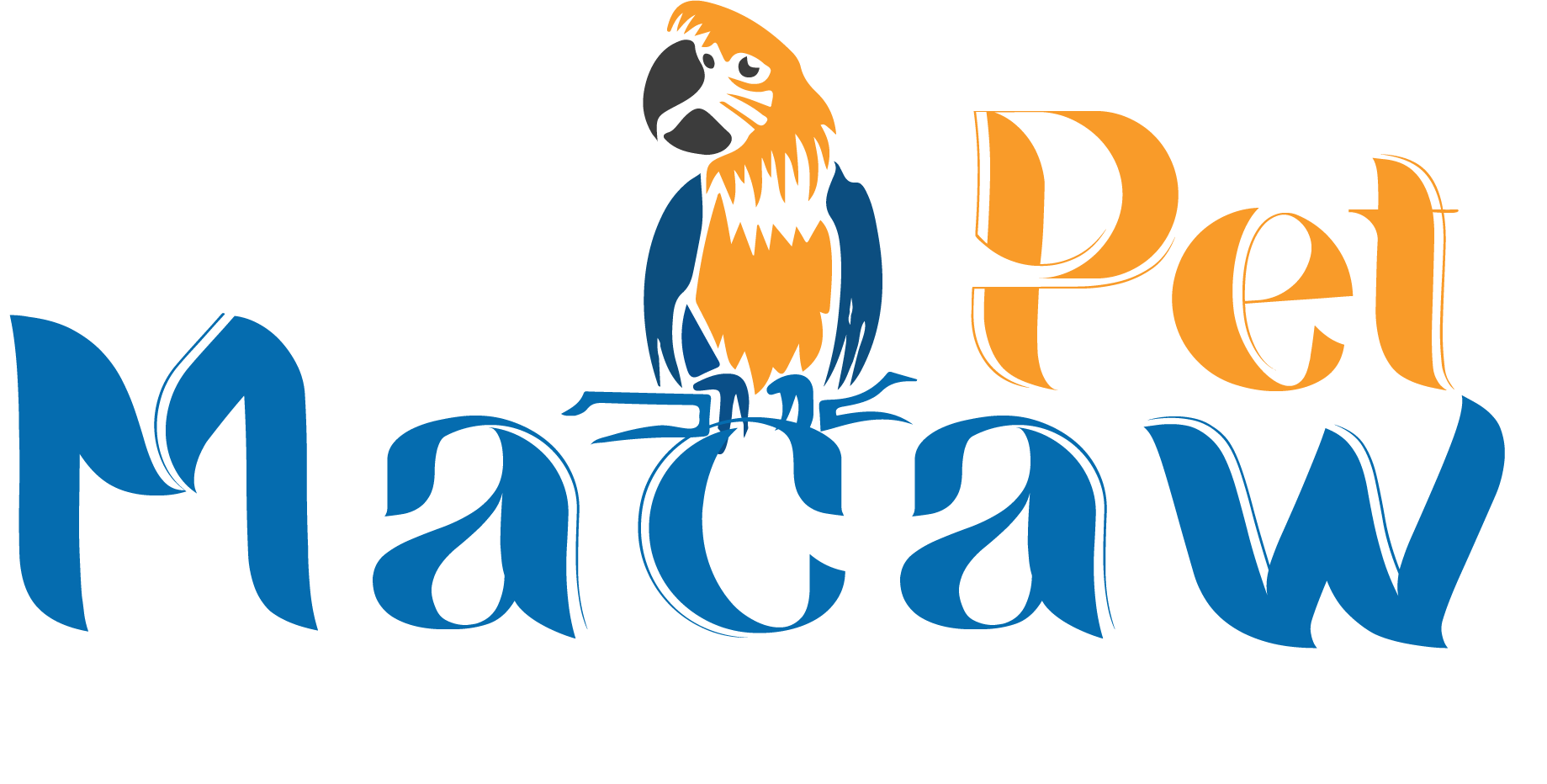Last Updated on May 9, 2022
The Blue Headed Macaws are one of the most beautiful parrots found in South America. They are naturally very calm & gentle and are also called mini macaws due to their smaller size. They are quite bigger than other parrots but smaller as compared to the other Macaws. Blue headed macaws are also named Coulon’s Macaw in an honor of Swiss naturalist Paul Luis Colon.
Are you searching for a complete guide about Blue Headed Macaw? Their looks, diet, breeding, and behavior? If yes, then you are in the right place. Below we discussed everything about Blue Headed Coulon’s Macaw. We are sure you will find everything you are looking for about a mini macaw.
Blue Headed Macaw
The Blue Headed Macaws, commonly known as Mini Macaws are primarily found in South America. They are called mini macaws due to their smaller size as compared to the other macaws. The name blue headed macaw is given because of their striking blue head. Although they have a full greenish body.
A few years back, they were considered quite common. But recently BirdLife International announced it as an Endangered Macaw Species due to its dangerously decreasing population.
Scientific Name of Blue Headed Macaw
The scientific name of Blue Headed Macaw is “Primolius Coulon”. The name is given after two different personalities. They belong to the “Pittacidae” parrot family and they have the “Primolius” genus. Furthermore, their family order name is “Psittaciformes”.
The scientific name “Primolious” was given as a tribute to Count Pietro Primoli di Foglia. He was a son of an Ornithologist from France named Prince Charles Bonaparte.
The other name Couloni was given as an honor to a Naturalist from Switzerland named Paul Luis Colon.
How Does a Blue Headed Macaw Look?
Blue headed macaws look very beautiful and astonishing. As their name states, they have a striking blue head with pale black beak and green wings. They have bright yellow eyes with red circles around the iris which makes a very beautiful appearance. The most beautiful part of their body is their long tail, usually in Blue & Green colors.
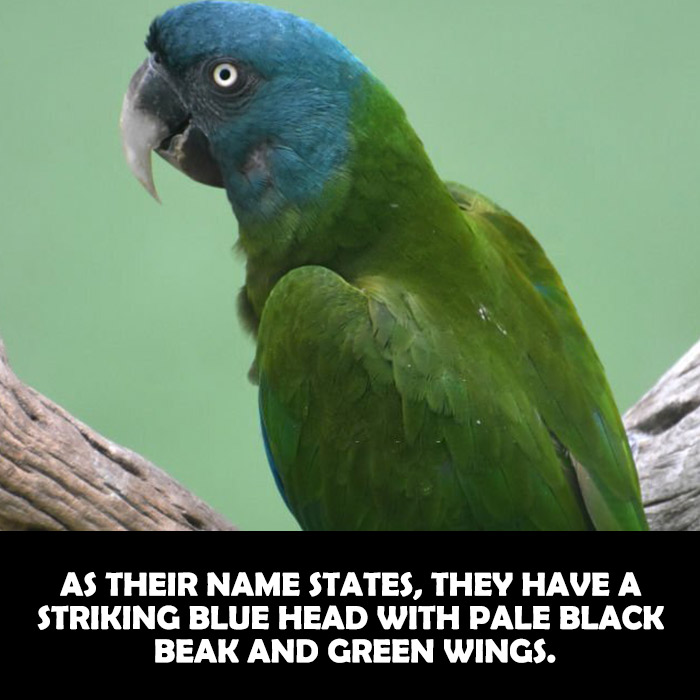
Moreover, Like other macaws, they have featured faces in green color. They have a green colored body which gives them a very handsome appearance. They have very strong gray or greenish claws which help them grip onto branches and search for food.
How Does a Male Blue Headed Macaw Look?
There is no difference in looks, but somehow Male blue headed macaw looks slightly bigger.
How Does a Female Blue Headed Macaw Look?
There is no difference between male and female Coulon Macaws in appearance. But Females are slightly smaller in size as compared to males. In some cases, they look so similar that only a DNA test can determine which one is male and female.
How Does a Baby Blue Headed Macaw Look?
A baby Blue Headed Macaw looks slightly different than their grown up version. They have a small black beak, almost featherless grey face, greenish head, almost featherless greenish body, and a smaller blue & green tail.
Furthermore, a baby blue headed macaw’s eyes are totally black when they are born and then gradually change their color towards bright yellow and red irises. They have grey claws and some upper portions of the body.
Voice of Blue Headed Macaw
Their voices are very soft and they like to be quiet most of the time. Although they made very purring calls, soft nasal, and slightly rasping notes.
When in captivity, it is noted that they make more noises at high volume. They make different noises and sounds in captivity like Kwaa, Kwaa…, Aawk, Aawk.., etc.
Size of a Blue Headed Macaw
They are medium sized macaws, generally sized between 15 to 16 inches from head to tail. A male blue headed macaw can be measured 16 inches. And Females are sometimes 15 to 15.6 inches from head to the tip of the tail.
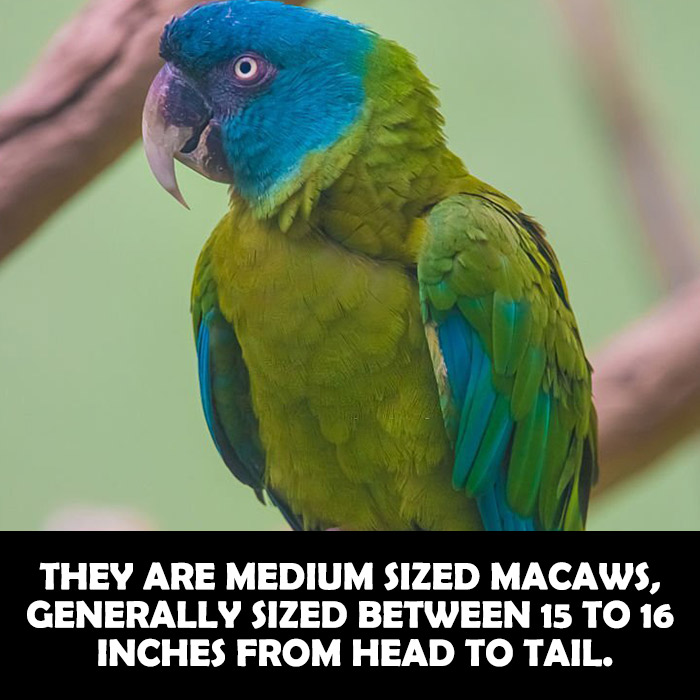
Moreover, their tails and beaks are slightly bigger according to their body. Their body is smaller and their tail is bigger. That is how they reach 15-16 inches, other than that their body is not bigger.
Weight of a Blue Headed Macaw
The Blue Headed Macaws average weighted between 207 to 294 grams depending on their size and age. A weight can be affected by different aspects of their age. Younger macaws are noted less in weight because their bodies are not fully developed yet.
Where Do Blue Headed Macaws Live?
Blue Headed Macaws are not very social, they usually live in pairs or small flocks. They prefer living on the edges of the forests along with rivers. They are mostly found in the rainforests of South America, Western Peru, Eastern Brazil, and Northwestern Bolivia. Moreover, they like to live in wooden surrounding areas like Costa Rica, Venezuela, and Trinidad.
As stated above, they do not like to be social, that is why they like quiet places. River edges in a quiet forest are an ideal place for them. Because it is easier to find food and peace there.
What Does Blue Headed Macaw Eat?
These parrots eat different varieties of Seeds, Fruits, Nuts, and some insects also. They mostly like things that are mineral-rich. Moreover, mineral-rich clay is their favorite. It provides them the ability to digest toxic fruits that are dangerous for other birds. And with the help of clay, they easily consume those foods.
Foods
In the wild, their food depends on the area they live in. Because what they easily get is what they can eat. They mostly tend to like greenery and mature & immature fruits. They eat fresh vegetables, fresh fruits, various types of nuts, and grains.
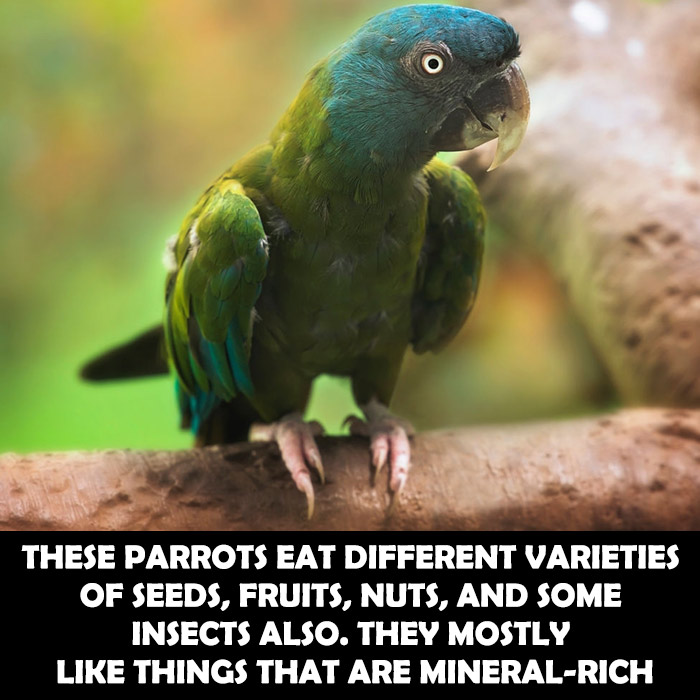
Suitable Food in Captivity
Captivity does not affect their eating habits. All macaws need mineral rich foods that give them high energy. According to some experts, Palm Nuts are the most important food for blue-headed macaws as they are rich in oil and calories. Moreover, they can eat a variety of vegetables like Pepper, Corn, Squash, Carrot, and Sweet Potato. In fruits, they like to eat chopped Apples, Papaya, and Grape. But remember, remove all seeds before serving fruits to your macaw. And in Seeds, they like Sunflower, Safflower, Oats & Hemp, and other varieties of seeds.
Breeding Behavior of Blue Headed Macaw
The blue headed macaw can fairly breed in both living in the wild and in captivity. Their ideal breeding time is Spring and the beginning of Summer. But some pairs breed all year round. Their breeding is mainly dependent on the environment.
Furthermore, their clutch size is usually 2-4 eggs. And their incubation period is 23 to 26 days.
Blue Headed Macaws can easily live in captivity, but they like vertical wooden boxes to live happily.
Moreover, they like to chew things almost every time. So, if you provide them a peaceful environment, they can easily mate with their partner and live a happy life.
Generally, they are very quiet birds but when living in captivity, they make noises. Maybe because of solitary. So, you have to keep in mind that they are only peaceful and quiet in the wild.
LifeSpan of Blue Headed Macaw
The life span of Coulon Macaw is very different in wild and captivity.
In the wild, their population is dangerously decreasing rapidly. Because living in the wild is full of problems for small birds. Big birds and animals hunt them for their food. They have to work hard and look for food on a daily basis even in harsh times. Rough changes in the environment and many other factors can make their life span short. Usually, they would not be able to live more than 10 years in the wild.
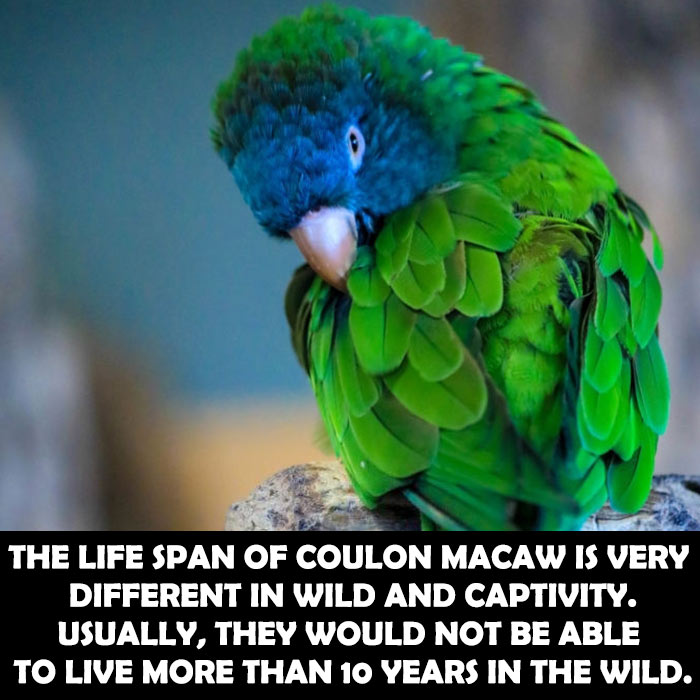
But on the other hand, they can live 20-30 years in captivity when treated well. This is because they do not have to hassle for food every day. There is less chance of manipulation by other big animals. There are fewer environmental changes. And most importantly there is someone who is taking care, and loving them. These factors made their life span longer.
Blue Headed Macaw Population
Blue headed or Coulon’s Macaw was considered quite common in the past. But, a survey by wildlife international stated that their population is dangerously decreasing day by day. According to them there are 900-2500 blue headed macaws left and the population is not increasing anymore.
Threats to Blue Headed Macaw
There are many threats to the population of Coulon’s Macaw. And the biggest one is deforestation. Commonly these parrots like to live near the edge of the forest. And we humans are manipulating the forest day by day to fulfill our needs and land requirements. That is why these birds have to move every time from one place to another. This makes them closer to the different dangers in the wild like bigger animals attacking or hunting.
Furthermore, there are other threats like illegal bird trade, harsh changes in the environment, and illegal hunting by humans. These are all threats to blue headed macaws and these are the possible reasons behind their decreasing population.
How Much Blue Headed Macaw?
Blue headed macaws are legal for captivity in the USA. But you have to purchase it through a legal breeder. And buying a blue headed macaw can cost you thousands of dollars. In the past few years, buying this bird was costing around 11,000$ to 12,500$. But now the prices have dropped from 4000$ to 5000$ in some European countries.
Moreover, there is not a big cost for petting them. As they mostly eat things that are easily available in the market.
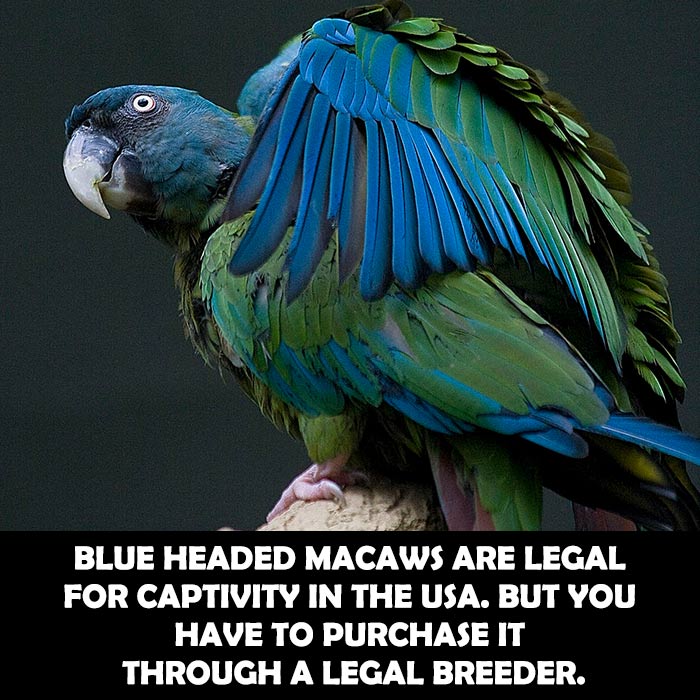
Blue Headed Macaw as A Pet
Blue headed macaws are proven to be very good and adorable pets. They live happily in captivity as compared to they live in the wild. Their lifespan gradually increases while being a pet. Moreover, they breed freely, mate easily with their partner, and live happily if they are treated well.
They need a spacious living space (because they are longer than common parrots), a healthy diet, and good care to be an ideal pet.
Other Similar Species
The Blue Headed Macaws are very rare but somehow they are relatives of the following Macaws.
- Yellow-collared Mini Macaws (Primolius auricollis)
- Illiger’s Mini Macaws (Primolius maracana)
Conclusion
Blue headed Macaws are very beautiful and adorable kinds of parrots. With their striking blue head, bright yellow eyes, and esthetically beautiful greenish wings. They can make you adore them in a matter of seconds. But sadly, their species is endangered. Their population is dangerously decreasing due to illegal hunting, illegal bird trading, and fast environmental changes. That is why it is very rare to find a blue head or Coulon’s macaw. Petting them is easy but it will cost you thousands of dollars to adopt them from a legal breeder.
Bilal is an aviculturist who loves to write in free time. His personal experience with bird care and breeding enables him to share valuable tips. So far, he has contributed more than 100 blogs to this site.
His goal is to promote bird-keeping and save endangered species.
